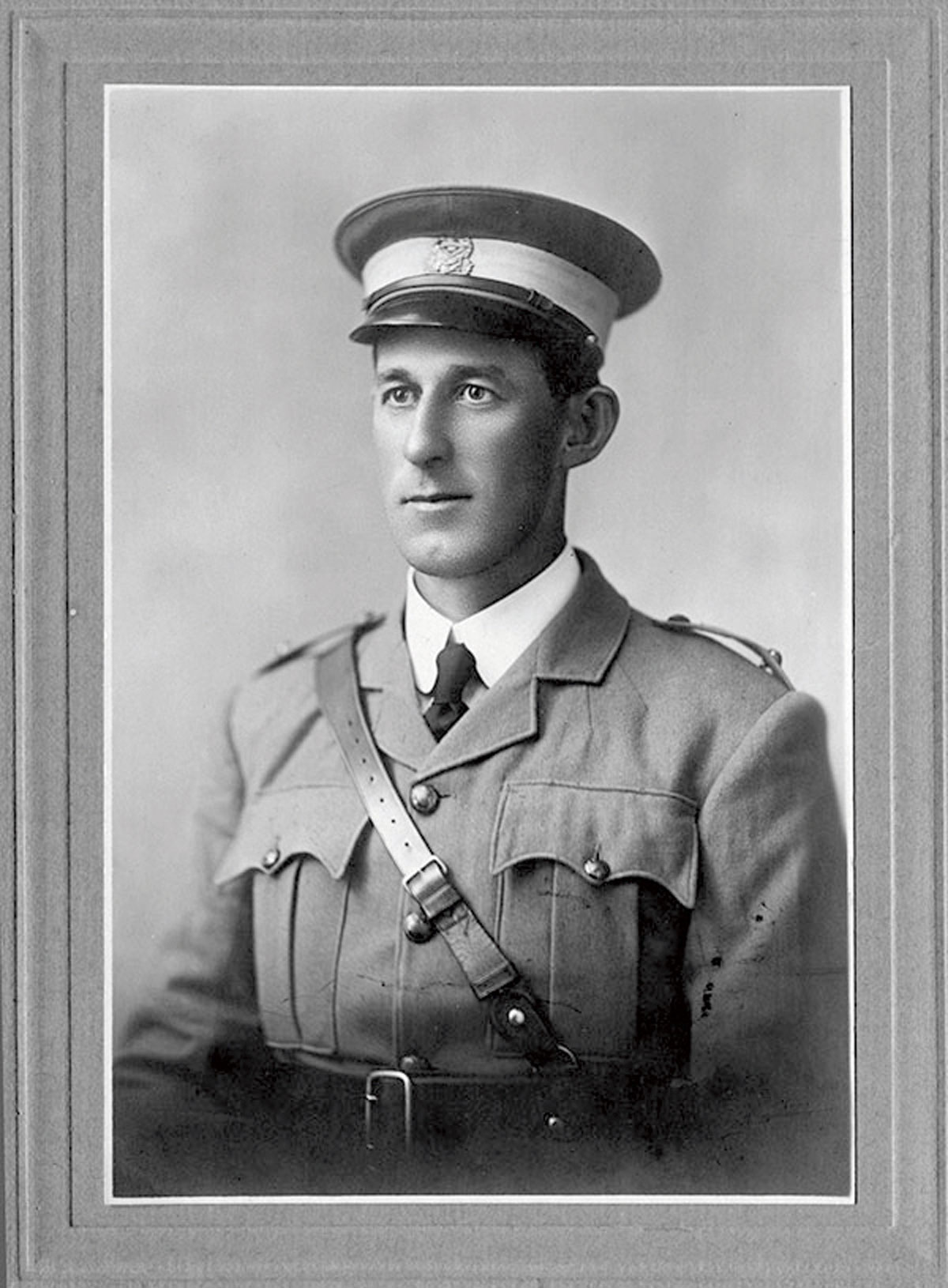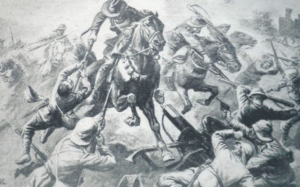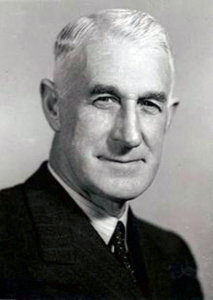The Battle of Beersheba
The charge of the 4th Australian Light Horse at Beersheba late in the afternoon of 31 October 1917, is remembered as the last great cavalry charge. The assault on Beersheba began at dawn with the infantry divisions of the British XX Corps attacking from the south and south-west. Despite artillery and air support, neither the infantry attacks from the south, or the Anzac Mounted Division’s attack from the east had succeeded in capturing Beersheba by mid-afternoon. With time running out for the Australians to capture Beersheba and its wells before dark, Lieutenant General Harry Chauvel, the Australian commander of the Desert Mounted Corps, ordered Brigadier General William Grant, commanding the 4th Light Horse Brigade, to make a mounted attack directly towards the town. Chauvel knew, from aerial photographs, that the Turkish trenches in front of the town were not protected by barbed wire. However, German bombing had forced the 4th Brigade into a scattered formation and it was not until 4.50 pm that they were in position. The Brigade assembled behind rising ground 6 kilometres south-east of Beersheba with the 4th Light Horse Regiment on the right, the 12th Light Horse Regiment on the left and the 11th Light Horse Regiment in reserve. The Australian Light Horse was to be used purely as cavalry for the first time. Although they were not equipped with cavalry sabres, the Turks who faced the long bayonets held by the Australians did not consider there was much difference between a charge by cavalry and a charge by mounted infantry. The Light Horse moved off at the trot, and almost at once quickened to a gallop. As they came over the top of the ridge and looked down the long, gentle open slope to Beersheba, they were seen by the Turkish gunners, who opened fire with shrapnel. But the pace was too fast for the gunners. After three kilometres Turkish machine-guns opened fire from the flank, but they were detected and silenced by British artillery. The rifle fire from the Turkish trenches was wild and high as the Light Horse approached. The front trench and the main trench were jumped and some men dismounted and then attacked the Turks with rifle and bayonet from the rear. Some galloped ahead to seize the rear trenches, while other squadrons galloped straight into Beersheba. Nearly all the wells of Beersheba were intact and further water was available from a storm that had filled the pools. The 4th and 12th Light Horse casualties were thirty-one killed and thirty-six wounded; they captured over 700 men. The capture of Beersheba meant that the Gaza-Beersheba line was turned. Gaza fell a week later and on 9 December 1917, the British troops entered Jerusalem.
Albert’s Story
Albert David Reid MC, a ‘long, lean, leathery’ Anzac, devoted virtually all of his adult life to public service. At municipal, state and federal government levels he was a dedicated member of the Australian Country Party. Committed to the needs of rural Australia, he made a significant contribution to the development of water conservation policy, and was a highly respected senator. He had a distinguished military career, serving in both world wars. Reid was born on 25 July 1886 at Murrumburrah in south-western New South Wales to David Reid, blacksmith and coachbuilder, and Margaret, née Cowden, both born in the ‘Mother Colony’. Albert was educated at Murrumburrah Intermediate High School and later apprenticed as a coachbuilder. In 1911 he became a farmer and grazier at Crowther, near Young. Reid’s long career in public service commenced in 1908 as a councillor at Murrumburrah. He was twenty-one.
On 31 October 1917 Reid wrote himself into Australian and military history when he led the second squadron of the 4th Light Horse in the famous and dramatic cavalry charge at the Battle of Beersheba, south of Damascus. Under heavy rifle and machine-gun fire from the Turkish defences, the squadron breached the first and second line of trenches. The charge enabled the 12th and the 14th regiments to capture all the enemy entrenchments. For his gallantry and devotion to duty in the field Reid received the Military Cross and was promoted to major later that year. Later in the Palestine campaign Reid led his squadron of Light Horse in a charge against a German-held position. The Germans fled before the horsemen, ending the final enemy stand in the drive to Damascus, and Reid was mentioned in despatches. Demobilised back to Australia he returned to his farm in Crowther and on 1 October 1919 married, at the Presbyterian Church, Murrumburrah, Jessie May Gibson, the daughter of an auctioneer.
Renewing an earlier association with the Farmers’ and Settlers’ Association, Reid would join a host of ex-servicemen who entered politics in the inter-war period, some of whom made the Country Party a formidable force in New South Wales politics in the 1920s. In October 1927 he launched his parliamentary career in the New South Wales Legislative Assembly when he won, by a narrow majority, the rural seat of Young. His photograph in the Daily Witness was captioned ‘Major A. D. Reid, who won the Young seat for the Country Party’. Losing his seat in 1930, Reid regained it in 1932 with the return of the UAP–Country Party Government and was re-elected in 1935 and 1938. In 1935 he was appointed Country Party Whip and combined his duties with those of party secretary and treasurer. In May 1938 he became Minister for Agriculture in the Stevens–Bruxner Government (1935–38). M. F. Bruxner, Deputy Premier and New South Wales Country Party leader, was a former Light Horse comrade, who had a great affinity with Reid. Reid continued to serve as Minister for Agriculture when the Mair–Bruxner Ministry took over in August 1939, remaining in office until May 1941 when both he and the Government were defeated by the ALP. During Reid’s term of office numerous water storage dams and weirs were built and irrigation schemes planned in the interests of primary producers and rural residents.
In 1941 Reid authorised a comprehensive ten-year water conservation program which formed the basis of all such projects implemented by succeeding governments, and included the construction of the Hume and Keepit dams. He chaired the New South Wales Water Conservation Commission and also developed plans for closer settlement in rural areas. His policies contributed to the gearing-up of the agricultural sector in New South Wales to meet wartime production. A few days after his defeat Reid enlisted in the second AIF, explaining that as he had been on the reserve list of officers he had offered his services to the army at the beginning of the war but had been advised to remain in his ministerial post. With the rank of lieutenant colonel he served for short periods as secretary to the state recruiting committee of the AIF and then as Deputy Director of Recruiting in New South Wales. Finally he occupied a staff position at Army Headquarters, Eastern Command. He retired from military service in September 1943. Reid first attempted to enter federal politics when he was preselected as the Country Party’s state candidate for the 1946 general election on a joint Liberal–Country Party Senate ticket, but he failed to win a seat. He was successful in the December 1949 election, which saw the size of the Senate increased and the introduction of proportional representation, and was elected third on a combined Liberal–Country Party team. He remained a senator until his death in 1962.
Reid spoke seldom, but from his first speech on 1 March 1950 his main concern was to protect the interests of primary industry. Approving of the proposal to establish a ministry of national development, he stressed the need for the new department to establish national water conservation schemes, citing the plan he had instituted in New South Wales. He emphasised the importance of hydro-electric power to provide electricity to the outback and thereby stem the population flow to the cities. He endorsed immigration as an aid to defence and development. He advocated increased funding for rural roads and the direct allocation of the petrol tax towards road construction and maintenance. His other rural concerns were equally predictable—wheat marketing, closer rural settlement, a rural ambulance service and the welfare of ex-servicemen. Reid was but one of the many democrats in the Parliament in the 1950s who justified aspects of the Communist Party Dissolution Bill that impinged on civil liberties in the belief that the threats posed by the Cold War demanded such a reaction. He rejected Opposition claims that the measure was designed to smash trade unionism: ‘If I thought that for one moment that that was the purpose of the bill, I should be one of the first to oppose it’. Unions, he said, should be prevented from being controlled by a communist minority, who planned first to overthrow the unions, then the whole community.
In 1951 he endorsed the controversial National Service Bill, criticising the Opposition’s argument that it allowed for the use of national service personnel against trade unionists and the civilian population. Reid served as a temporary chairman of committees from 1951 to 1953, becoming a respected and impartial Chairman of Committees (1953–62) and succeeding another former Light Horseman, Senator George J. Rankin. He was quick to respond to ‘objectionable unparliamentary’ language and generally his rulings evoked little dissent. According to the Leader of the Opposition in the Senate, Nick McKenna, Reid was always willing to cooperate with members of the Opposition when they required time to debate a bill’s clauses. He served also as vice-chairman of the Joint Committee on Public Works and as a member of the Senate’s Standing Orders Committee. He was a member of the Australian parliamentary delegation to the coronation of Queen Elizabeth II in 1953 and to the Commonwealth Parliamentary Association conference in 1959.
In his extra-parliamentary activities he had been vice-president and central executive member of the Australian Country Party and a council member of The Scots College, Sydney. Senator Reid, who lived at 51 Lindfield Avenue in the Sydney suburb of Lindfield, died on 22 May 1962 at the Repatriation General Hospital at Concord in Sydney, less than six weeks before the end of his Senate term. He had not stood for the 1961 election. The funeral service, at St Stephen’s Presbyterian Church, Macquarie Street, Sydney, was attended by members of both of federal and state parliaments representing all political parties. The funeral rites were conducted at Northern Suburbs Crematorium, Sydney. Reid’s wife, and two sons, Ian and Keith, survived him; a daughter, Marion, died earlier. Senators spoke kindly of Reid’s ‘long and meritorious public service’. Senator McKellar stated that Reid was ‘the most unselfish man’ he had known, and acknowledged his deep religious convictions and commitment to the Presbyterian Church. In the House, Prime Minister R. G. Menzies paid tribute with his inimitable eloquence: It is well to remember, when we speak about a man of this kind, that we use no ordinary form of words. We are commemorating services which have built themselves into the fabric of self-government in Australia, and when we speak of them all are their debtors.



